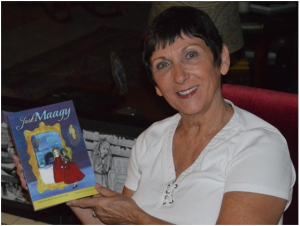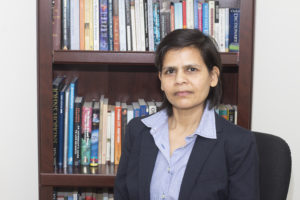From time to time, Archway Publishing turns over its blog to its authors, giving them the opportunity to share stories and perspectives about their individual self-publishing journeys. The following are the words of Virginia Stringer, author of “Just Maagy”. Connect with Virginia on Facebook and her website. Download the Archway Publishing free publishing guide for more information on our supported self-publishing services.
My book is “Just Maagy“. It started out as a fifty-minute children’s play but then turned into a short story that wasn’t so short. It was ignored for a few years and then it found its way to my face again and took on a life of its own spawning a six-book chapter book series over the course of eleven years. Then it became my fourth child!
In fact, the main character, Princess Melania Abigail Alice Grace, are my daughters and granddaughters in a manner of speaking.
 Maagy, as her father calls her, is a spoiled little brat who readers meet on her thirteenth birthday, when she throws a tantrum because there is no more spumoni ice cream for breakfast. Like I said, my daughters and granddaughters.
Maagy, as her father calls her, is a spoiled little brat who readers meet on her thirteenth birthday, when she throws a tantrum because there is no more spumoni ice cream for breakfast. Like I said, my daughters and granddaughters.
Maagy is strong willed, exceedingly smart, cunning and perceptive. She is also stubborn leading her father to give in and allow her to attend school outside the palace, where she begins to understand the meaning of true friendship. However, life is always full of twists and turns and Maagy is not spared.
When I decided to share Maagy with the world, it was a huge leap of faith and a gut wrenching choice, thinking of her out there on her own. I began considering my publishing options. I spent a considerable time researching literary agents, but found their websites and their entire business to be unfriendly and not at all encouraging to new writers. The overall theme was, “If you want to get published, you’ll have to go through me and hope your book parts the Red Sea, because that’s the only way you’re getting to a publisher’s desk! Oh, and we’ll rewrite it to suit us and you can kiss our grits!”
That attitude did not go over well with me! I was not about to put my life’s artistic accomplishment in the hands of literary agents to chop and “commercialize” it into their dream!
I spent a weekend, crying, uttering a few choice words and almost hit “delete”! My husband talked me off the ledge and said, “Why don’t you self publish? You’ll have all the control and no one will mess with your art.”
Writing is an art form…
So giving over my work to someone else to cut and edit, in my opinion, is like a museum curator saying to a painter, “I’ll put blue in place of red, change the man to a woman, remove the mountains and then hang it in my gallery!” I couldn’t live with that.
However, no one can ever edit his or her own work, effectively!
 I have a group of “readers” who function as editors. They give me content feedback, ask questions and point out typos and mistakes. They are all well educated except for the children who read for me and come from different backgrounds and professions. All are avid readers and will give me honest critique, without telling me I have to change this or that if I want it published. They do not interfere with my artistic process, but do speak to me from an outside perspective, which is vital to knowing how my work will be received. They are teachers, financial advisers, actors, poets, scientists, friends and family members about ten to fifteen, in all.
I have a group of “readers” who function as editors. They give me content feedback, ask questions and point out typos and mistakes. They are all well educated except for the children who read for me and come from different backgrounds and professions. All are avid readers and will give me honest critique, without telling me I have to change this or that if I want it published. They do not interfere with my artistic process, but do speak to me from an outside perspective, which is vital to knowing how my work will be received. They are teachers, financial advisers, actors, poets, scientists, friends and family members about ten to fifteen, in all.
The big difference is I have the final say, as to whether I heed the advice. In most cases, I take the suggestions to heart and make revisions… some minor and some major!
Every new and old writer needs readers!
So… I looked up “self-publishing” and Archway was first on the list. Simon and Schuster Publishing is the parent company, lending credibility, before I even went further and spoke to a human, which, by the way, the literary agencies did NOT offer.
Having expressed interest through email, a real person called in less than 24 hours! The conversation was informative, enlightening and friendly!! All of my misgivings were put to rest and I asked for a week or so to mull it over. I was not pressured, “sold” a product or made to feel unimportant. A week or so later, the very friendly voice was back and I asked a few more questions and mulled some more.
Overall, I am pleased with my decision to go the self-publishing route and Archway has been fabulous to work with at every step of the way. The support services and staff have been exceedingly helpful, though, not inexpensive. However, I consider it money well spent!
In fact, I am publishing the entire Maagy series at present count, six books through Archway Publishing!
Archway Publishing is always looking for content for its blog. If you’re an Archway Publishing author and would like to share an idea for a guest blog post, please tweet the Archway Publishing Twitter account @ArchwayPub and Like the Archway Publishing Facebook page.
 In 2014, I set out to publish Growing Up without My Daddy. I wrote this book to share insights from own childhood experience in the hopes of helping those who are going through what I did. With my book, I wanted to teach young girls how to move beyond their hurt through trusting in God’s gift of love. Ultimately, Growing Up without My Daddy is a book which seeks to help parents begin a conversation with their children. My book is a reminder to fatherless girls that they are loved and lovable by their mere existence. Continue reading
In 2014, I set out to publish Growing Up without My Daddy. I wrote this book to share insights from own childhood experience in the hopes of helping those who are going through what I did. With my book, I wanted to teach young girls how to move beyond their hurt through trusting in God’s gift of love. Ultimately, Growing Up without My Daddy is a book which seeks to help parents begin a conversation with their children. My book is a reminder to fatherless girls that they are loved and lovable by their mere existence. Continue reading 








 ttention to the plot of your novel, or focus of your non-fiction work. You’ve edited, re-edited or enlisted the help of a professional editor to ensure that the text flow. But before you hit submit, it’s important that you review some of the less prominent, but equally important parts of your work.
ttention to the plot of your novel, or focus of your non-fiction work. You’ve edited, re-edited or enlisted the help of a professional editor to ensure that the text flow. But before you hit submit, it’s important that you review some of the less prominent, but equally important parts of your work.
